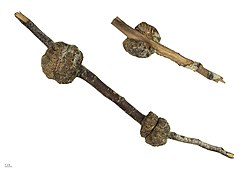| Cyttaria | |
|---|---|
 | |
| Cyttaria from Chile growing in a tree branch | |
| Scientific classification | |
| Domain: | Eukaryota |
| Kingdom: | Fungi |
| Division: | Ascomycota |
| Class: | Leotiomycetes |
| Order: | Cyttariales |
| Family: | Cyttariaceae |
| Genus: | Cyttaria Berk. (1842) |
| Type species | |
| Cyttaria darwinii Berk. (1842) | |
| Species | |
C. berteroi | |

Cyttaria is a genus of ascomycete fungi. About 10 species belong to Cyttaria, found in South America, Australia and New Zealand, associated with or growing on southern beech trees from the genus Nothofagus . [1] The "llao llao" fungus Cyttaria hariotii , one of the most common fungi in Andean-Patagonian forests, [2] has been shown to harbor the yeast Saccharomyces eubayanus , which may be source of the lager yeast S. pastorianus cold-tolerance. [3] Cyttaria was originally described by mycologist Miles Joseph Berkeley in 1842. [4]